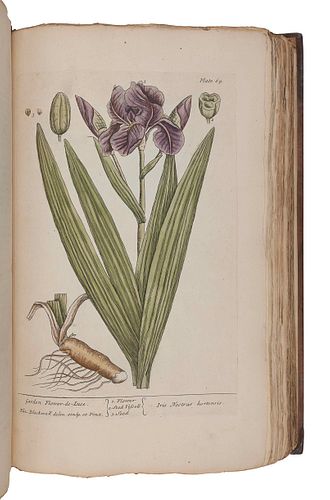BLACKWELL, Elizabeth (d.1758). A Curious Herbal, containing Five Hundred Cuts of the most useful Plant which are now used in the Practice of Physick.
Lot 9
About Seller
Hindman
1338 West Lake Street
Chicago, IL 60607
United States
Recognized as the Midwest's leading fine art auctioneers, Hindman Auctioneers has built a worldwide reputation based on a full service approach to the auction business tailored to meet the individual needs of our clients. Coming from a variety of educational backgrounds, specialists bring years of e...Read more
Categories
Estimate:
$15,000 - $20,000
Absentee vs Live bid
Two ways to bid:
- Leave a max absentee bid and the platform will bid on your behalf up to your maximum bid during the live auction.
- Bid live during the auction and your bids will be submitted real-time to the auctioneer.
Bid Increments
| Price | Bid Increment |
|---|---|
| $0 | $25 |
| $500 | $50 |
| $1,000 | $100 |
| $2,000 | $250 |
| $5,000 | $500 |
| $10,000 | $1,000 |
| $20,000 | $2,500 |
| $50,000 | $5,000 |
| $100,000 | $10,000 |
About Auction
By Hindman
Oct 8, 2020
Set Reminder
2020-10-08 11:00:00
2020-10-08 11:00:00
America/New_York
Bidsquare
Bidsquare : Selections from the Library of Gerald and Barbara Weiner
https://www.bidsquare.com/auctions/hindman-auctions/selections-from-the-library-of-gerald-and-barbara-weiner-5544
Hindman Bidsquare@hindmanauctions.com
Hindman Bidsquare@hindmanauctions.com
- Lot Description
BLACKWELL, Elizabeth (d.1758). A Curious Herbal, containing Five Hundred Cuts of the most useful Plant which are now used in the Practice of Physick. Engraved on folio Copper Plates, after Drawings, taken from the Life... To which is added a short Description of ye Plants and their common Uses in Physick. London: John Nourse, 1739.
2 volumes, folio (398 x 247 mm). 2 engraved titles, 4 engraved dedicatory leaves, 2 engraved leaves "English Index," 2 engraved leaves "Catalogus Plantarum," 125 engraved leaves of explanatory text and 500 hand-colored plates (some minor pale foxing and offsetting throughout, plates 113-116 and their explanatory text leaf bound after 117-120 in Vol. I, some minor marginal worming on upper margins of some plates at end of Vol. I, some toning to plates at beginning of Vol. II and occasionally elsewhere, Plate 354 with 5-inch repaired tear crossing image, occasional marginal finger-soiling). Contemporary mottled calf, edges uncut (rebacked, some edge repairs, worn). Provenance: purchased from Hamill and Barker, 1966; Anita Peek Gilger copy (sold Christie's New York, 14 October 2003, lot 11). Henrey's fourth issue, except here the dedication in vol. II is to Robert Nicholls and vol II. is without the dedications to Henry Plumptre, Joseph Miller or John Johnstone. The work's bibliographical history is complicated and not fully documented. "There is no uniformity with regard to the number of dedications contained in the various issues, or in the order in which the preliminary leaves are arranged" (Henrey). Elizabeth Blackwell undertook the work with the encouragement of various eminent members of the medical profession and with the intention of paying off her husband Alexander's debts. She took a house opposite the Chelsea Physic Garden, at 4, Swan Walk, at the suggestion of Isaac Reed, in order to draw and engrave the plants. Her husband helped by supplying the common names of the plants in various languages. The work was a success, and she achieved her object. She accompanied her husband to Sweden where he was employed as an agricultural expert (Linnaeus visited him in 1746), but he unfortunately became involved in politics, was arrested and eventually beheaded on 29 July 1747, for his part in a conspiracy to alter the Swedish succession. Elizabeth, who died in 1758, is buried in the churchyard of Chelsea Old Church. Cleveland Collections 386; Dunthorne 42; Great Flower Books, p.50; Henrey 453; Hunt 510; Lisney 175 and 180; Nissen, BBI 168; Pritzel 811; Stafleu & Cowan TL2 545.
For condition inquiries please contact Gretchen Hause at gretchenhause@hindmanauctions.comCondition
- Shipping Info
-
Please refer to https://hindmanauctions.com/shipping-packing
-
- Buyer's Premium



 EUR
EUR CAD
CAD AUD
AUD GBP
GBP MXN
MXN HKD
HKD CNY
CNY MYR
MYR SEK
SEK SGD
SGD CHF
CHF THB
THB















